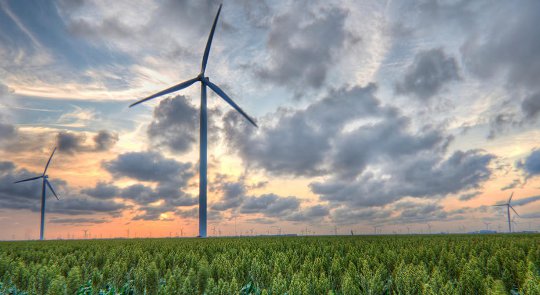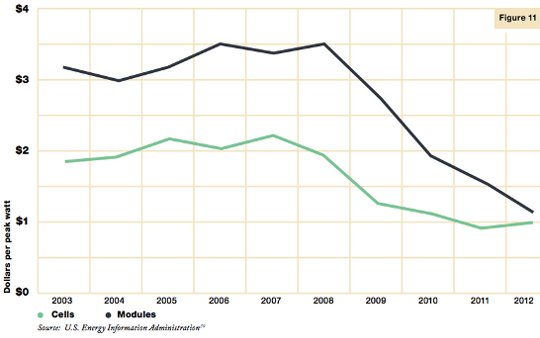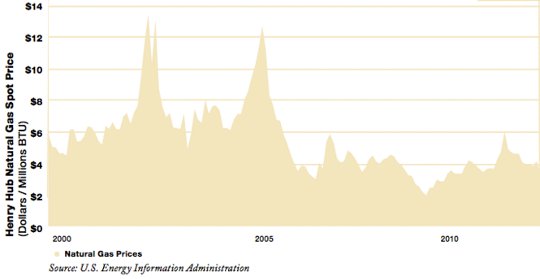
Photo: Drew Kolb. A wind farm north of Corpus Christi, Texas
Texas is known for cheap and plentiful energy resources, but they’re usually of the dirty, fossil fuel–based variety. That reputation is changing. Texans can now buy renewable energy packages that are as cheap as or cheaper than the coal- or natural gas–based alternatives.
Texas is not an anomaly. A study released by the venture capitalist firm DBL Investors shows that states boasting robust green energy programs have the nation’s cheapest electricity. The trend lines suggest it’s only going to get better for their consumers. In 2001, electricity cost more in the 10 top renewable energy states than it did in the 10 states with the lowest proportion of green energy production. By 2013, the situation had turned upside down: States with the most green energy now offer cheap electricity, while the dirty power states are the most expensive.
You could probably figure out whether you’re in a top 10 or bottom 10 renewable energy state by tracking your utilities payments over the past few years. Just in case you don’t archive your electricity bills, the 10 states with cheap green energy are Maine, Iowa, South Dakota, California, Idaho, Kansas, Minnesota, North Dakota, and Oklahoma, plus Washington, D.C. (Hawaii also has a high proportion of renewable energy, but it was excluded because its remoteness dictates energy prices more than any other factor.) The 10 laggard states in the DBL study were Florida, Connecticut, Delaware, South Carolina, West Virginia, Rhode Island, Ohio, Missouri, Tennessee, and Kentucky.
What happened? Technology. The sun and the wind are free. (It sounds like something from a Joni Mitchell song, but it’s true.) The price of renewables is therefore based almost entirely on the cost and efficiency of the hardware that captures the energy. That’s a good thing, because, over the past few decades, engineers have demonstrated an incredible knack for making technology smarter, faster, and cheaper. (See, for instance, Moore’s Law.) The cost of fossil fuel–based electricity, in contrast, depends overwhelmingly on commodity prices. There’s only so much that engineers, economists, and logistics experts can do to manage the swings in coal and natural gas prices.
This is a big advantage for renewables. The cost of wind power has dropped 58 percent in the past five years. Take a look below at what has happened to the cost of solar cells and modules over the past decade. It’s not a precipitous drop, but there is an obvious downward trend.

Illustrated by: DBL Investors
Compare that to the wild swings in the cost of natural gas below. There’s no discernible pattern. The price can increase by a factor of six over the course of five years, then decrease by the same amount in four years.

Illustrated by: DBL Investors (cropped by InnerSelf to start at 2000)
Imagine you’re an accountant at a utility company and have to do some projects for the next few years. Which of these graphs do you want to deal with?
This isn’t just a feel-good study about the success of renewables; it’s a direct challenge to the dishonest lobbying of fossil fuel interests. The American Legislative Exchange Council—the secretive coalition of corporative executives who want to write their own state laws—is currently trying to dismantle renewable portfolio standards, the rules that require utilities to generate a proportion of their energy from green sources. This Koch Industries–funded “think tank” claims that “green energy mandates replace the free market with bureaucratic government oversight, driving up costs.”
I wanted to start this paragraph with “The Koch machine has never been so wrong,” but that’s not accurate. Koch mouthpieces are wrong about so many other things, often spectacularly so. But this is a fairly clear lie. The DBL study is correlational—it doesn’t prove that green energy caused prices to drop; it merely shows that green energy states tend to have lower prices. Nevertheless, the accumulating data makes it very difficult to substantiate the claim that renewable portfolio standards increase electricity costs. Including a high proportion of renewable energy in a utility’s mix of sources does not increase prices.
The Koch machine won’t stop saying so, of course. They tend not to worry about things like “studies” and “research.” But you should.
This article originally appeared in OnEarth
 About the Author
About the Author
Brian Palmer covers daily environmental news for OnEarth. His science writing has appeared in Slate, the Washington Post, the New York Times, and many other publications.
Related Book:
at

Thanks for visiting InnerSelf.com, where there are 20,000+ life-altering articles promoting "New Attitudes and New Possibilities." All articles are translated into 30+ languages. Subscribe to InnerSelf Magazine, published weekly, and Marie T Russell's Daily Inspiration. InnerSelf Magazine has been published since 1985.

Thanks for visiting InnerSelf.com, where there are 20,000+ life-altering articles promoting "New Attitudes and New Possibilities." All articles are translated into 30+ languages. Subscribe to InnerSelf Magazine, published weekly, and Marie T Russell's Daily Inspiration. InnerSelf Magazine has been published since 1985.


























